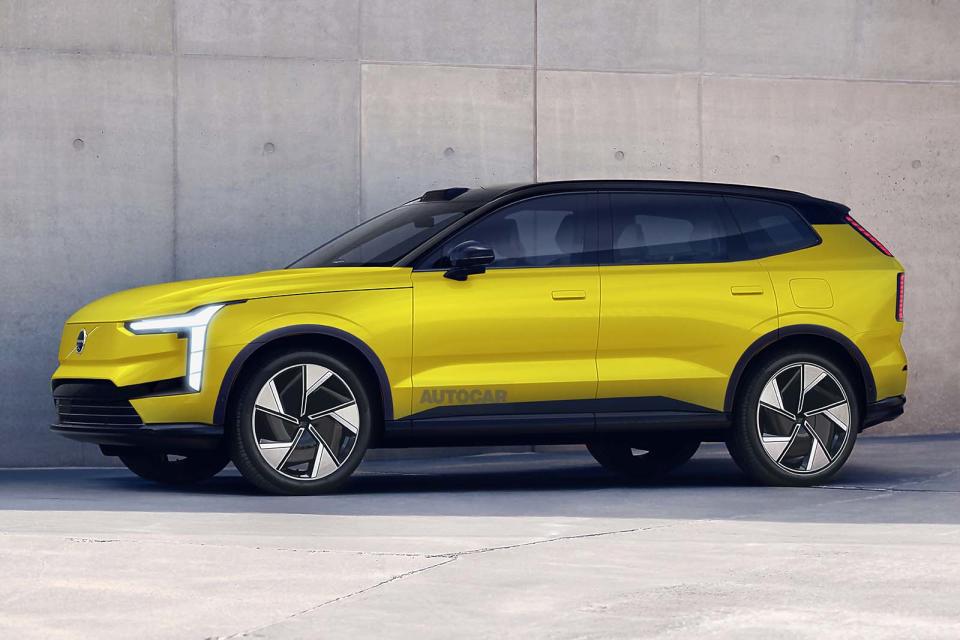New Volvo EX60 tipped to introduce radical production process

EX60 would slot into Volvo's line-up alongside the petrol XC60, its best-seller
Volvo will introduce mega-casting into the production of its next-generation electric cars, due in 2026 – a move it says will greatly improve efficiency and create more freedom for future vehicle design and manufacturing.
The firm says the advanced manufacturing process will be introduced on the next-generation EVs produced at its main Torslanda plant in Sweden.
Although the manufacturer has given no technical details, this will tie in with the planned introduction of the SPA3 platform – which is a development of existing architectures and being used to signal the third generation of the firm’s bespoke electric cars.
Erik Severinson, Volvo’s head of strategy and programme management, declined to comment on the first model to be produced on that platform.
He said: “What I can say is that by 2030 we have committed to being fully electric, and by then we need to redo our whole product portfolio to have electric options for all our customers. And that requires a lot of new cars between now and 2030.”

Given Volvo’s focus on SUVs, the clear gap in its electric line-up is an EX60, which would sit alongside the XC60, its current best-seller. That model had been expected to arrive in 2025 and its position as one of the firm’s most significant products would make Torslanda a natural choice as a production site.
The mega-casting process involves producing large single car parts formed by pouring molten metal into a die-cast mould. That enables large sections of a car platform to be produced as single pieces, rather than manufacturing numerous separate parts and welding or bolting them together. The technique is already used by Tesla and Toyota will introduce it on future models.
Volvo will start by producing the rear floor section of its next-generation models as a single aluminium piece using the mega-casting technique. The firm says this will be a single car part and replace around 100 parts used previously. Because of that reduced complexity, the rear floor will have 84% fewer welded joints and weigh around 50% less.
According to Mikael Fermér Volvo’s vehicle platform lead architect, the process will revolutionise the firm’s approach to construction. He noted that, at present, the fixed points and structures of a platform mean that it essentially has a shelf life once launched.
But because the megacast parts can be changed simply by adapting the moulds – which need maintenance every four months or so – it becomes much easier to make substantial changes to the structure, effectively giving a platform “an unlimited lifespan”. That could also lead to more rapid deployment of new vehicle types.
Volvo is aiming to increase the use of mega-casting in future years, with the ultimate goal of producing much of the platform as a handful of pieces.
Fermér said the floor is “a good starting point” because “it’s fairly easy to design a safe and robust rear floor. You have a lot of complicated interfaces that you replace when you go from 100 parts to one”.

He added that “it’s your imagination” that limits what can be done with mega-casting, but said: “It should always be based on the business case and function. We have looked into casting a complete battery tray, which makes sense because it could replace many parts.”
Fermér also said there are no concerns over safety, or potentially higher repair costs if a large mega-cast part is damaged – an issue that Tesla has been striving to resolve with some insurance firms. He noted Volvo’s long-standing commitment to safety, adding: “We end the mega-cast piece behind the wheelhouse and then have a bumper beam and a rear crash structure, which is a big part that we can crush and replace.
“It is possible to repair a mega-cast part to some extent, but if it’s a really severe crash, then it will be scrapped. But that’s the same for a traditional car, and probably about as likely as the main body of a current car being written off.” As well as the advantages in car design, mega-casting offers several production benefits.
These include major reductions in CO2 emissions – not just from production, but also through reducing the number of parts that need to be shipped in from outside suppliers or other Volvo factories. It allows for significantly higher material utilisation too, because any leftover aluminium can simply be melted down and re-cast.
Volvo will initially use new pressed aluminium for the process because of the need for quality control, but it is evaluating the use of recycled metal in the future – or even bringing in readymolten aluminium.
The huge mega-casting machine Volvo has constructed can cast a single rear tray in around 120 seconds and running two in parallel means it can meet the demands of the production line to produce around 60 cars an hour.
Volvo’s new mega-casting facility at Torslanda is part of a major £800 million upgrade to prepare the site for future electric car production. The company will also open a new battery assembly plant, which will construct packs using cells produced at an adjacent new production facility that will be operated by partner firm Northvolt.
Volvo also plans to use mega-casting at a new factory currently under construction in Slovakia and it could eventually be introduced across its other global plants as the need arises.
]]>

 Yahoo Autos
Yahoo Autos 